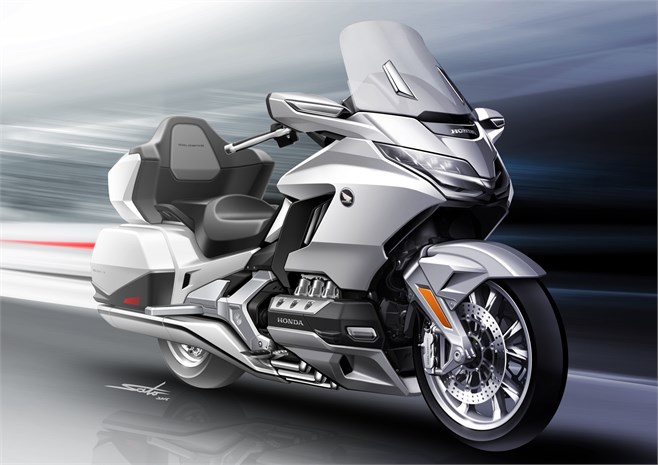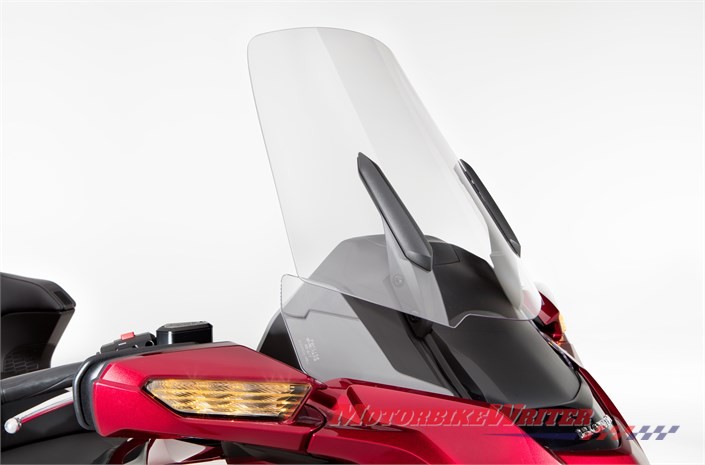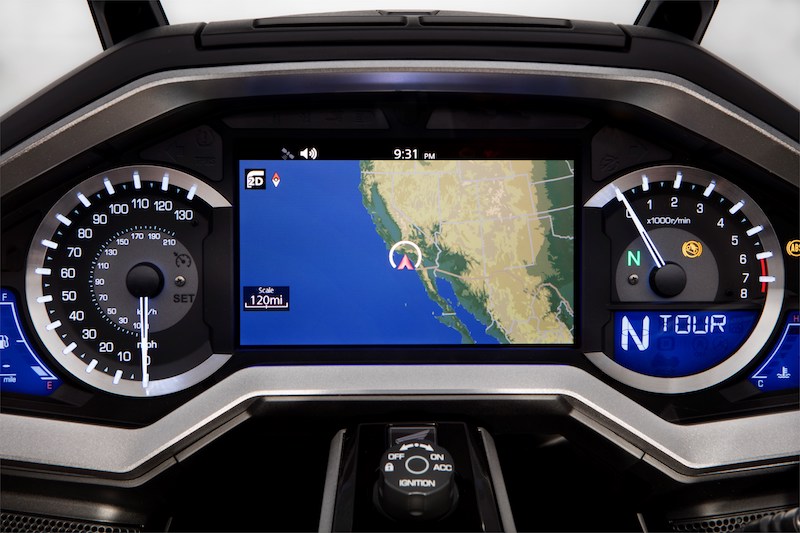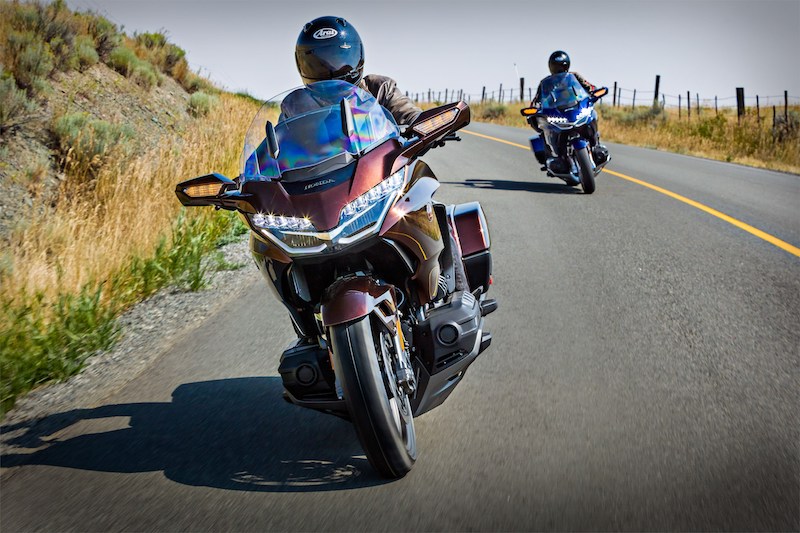The 2018 Honda Gold Wing has shed up to 48kg of weight, has an electric windscreen, seven-speed automatic transmission, traction control and a link front fork.
It is also more hi-tech with Apple CarPlay that allows iPhone users to use their device, smart key, electronic suspension, four power modes, LED lighting and auto-cancelling indicators.
But it has a smaller fuel tank and almost a third less luggage space.
Honda claims the restyled new Wing is now just as happy on an urban commute as a long-haul tour.
The more aggressive-looking bike was revealed today at the Tokyo Motor Show in base form and a Tour version with the top box, DCT and an airbag.

Honda Motorcycles Australia says the new Goldwings are due to arrive in February, but pricing won’t be available until closer to arrival.
As a guide, the current models are: Goldwing $38,186 (rideaway in Brisbane); F6B $29,285 and Valkyrie (F6C) $23,800.on pricing or arrival.
Honda says the 2018 Gold Wing is “brand new from the wheels-up”. They claim it is lighter, smaller and more agile to appeal to a younger rider.
Yet it is still powered by the same flat six-cylinder engine. There was no talk of rumoured smaller capacity or hybrid versions.
Gold Wing project leader Yutaka Nakanishi says it is “more exciting to ride than ever”.
“So we started from a blank piece of paper and made the Gold Wing smaller and lighter, and added all the technological hardware and software the modern rider could wish for,” he says.
Here are the details from the Honda press release.
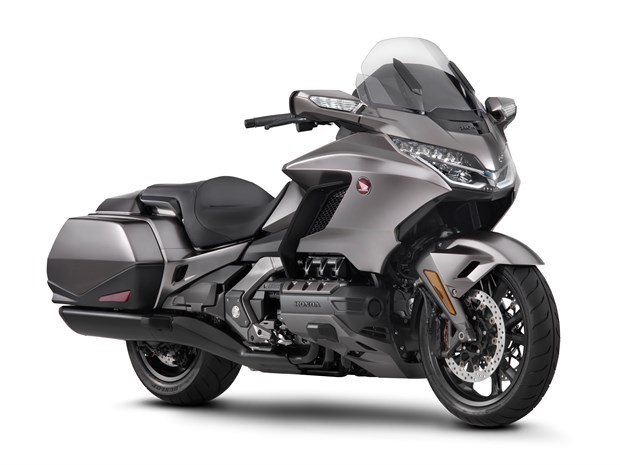
Smaller Wing
The engine and chassis have been designed together to move the riding position forward and create a “much more compact motorcycle”.
It features an aluminium beam frame constructed around the link front fork to allow the engine to come further forward.
Honda claims the forks provide high-quality suspension control and front-end stability thanks to its stiffness and reduced friction. Suspension damping can also be adjusted electrically.
The updated flat six-cylinder engine retains the same power and torque, but now has Throttle By Wire with four rider modes; TOUR, SPORT, ECON and RAIN.
Honda Selectable Torque Control (HSTC) maintains rear wheel traction while the suspension damping and Combined Brake System (CBS) alter depending on mode selected.
It also features Hill Start Assist (HSA) for those who can’t handle a hill start and Idling Stop which means the engine shuts down when stopped.
It’s a fuel saving feature that has been included in many cars for several years.
The manual transmission is now six-speed, while the new Dual Clutch Transmission (DCT) is seven-speed.
It has clutch feel, shift speed and rpm range of up/downshifts tailored specifically to each riding mode. It also features a creep forward and back function for parking.
The manual Gold Wing has the same reverse system as previously.
The 2018 Gold Wing comes in Matte Majestic Silver and the Tour comes in Candy Argent red and Pearl Glare White.
Tour with DCT and airbag comes in Candy Argent Red/Darkness Black and Darkness Black metallic.

Creature features
Honda claim the development team worked on improving comfort, heat management and air management.
They say the fairing is now more aerodynamic and channels cooling air around the rider.
The windscreen is now smaller, but they say it is more effective and is electronically controlled by a button on the left handlebar.
There is also a larger screen and fully-adjustable upper and fixed lower deflectors available.
The lower portion of the LED headlights use five polished optical lenses on both sides to create a Jewel-Eye low beam light signature.
Honda says high beam (in the upper portion) creates a “stereoscopic impression”. The front indicators are housed in the mirrors and are self-cancelling.
The automatic indicator system compares front and rear wheel speed difference to calculate signal cancellation.
Cruise control is now on the right right handlebar and the set speed is shown in the bottom left of the speedometer.
Honda claims the throttle-by-wire system makes cruise settings smoother, especially when going uphill. It works on the manual and DCT versions.
Some of the weight saving is obviously from the smaller luggage capacity.
The top box still holds two full-face helmets, but total luggage capacity is now 110 litres down from 147L.
Latches can be operated by the smart key.

Honda claims they researched current owners and found they used the bike for only 2-3 day tours, so they didn’t need as much luggage capacity.
Lighter weight and better aero, plus a new, cleaner engine means fuel economy is improved for 5.6L/100km.
So Honda has also dropped the fuel capacity 4 litres to 21L and claims “similar” range to the previous model.
The LED instruments feature different low-contrast colours and metal rings around the dials.
The 7-inch full-color TFT liquid crystal display screen show audio and navigation information, as well as traction control, suspension adjustment and tyre pressure monitors.
Brightness adjusts automatically to ambient light or the rider can also choose from 8 brightness levels.
In the centre of the dash is the new 3D and two-tone Gold Wing emblem that incorporates the emergency key. The ignition and handlebar lock can be turned on or off while just carrying the smart key.
Gold Wing is now compatible with Apple CarPlay, so the rider can access their iPhone contacts and music via Bluetooth. There is also a USB cable.
Hondas claims to have upgraded the sound system with better-quality lightweight speakers and the passenger can control the sound via switches on the right pannier.
The navigation system now includes a gyrocompass for guidance inside a tunnel. Cancellation of any waypoint or ‘go home’ instruction operation while riding is now possible.
Gold Wing chassis
The new Gold Wing’s die-cast aluminium twin beam frame is designed to package the more compact engine in a tighter space, 40mm further forward.
Its structural thickness has been optimised in each area for a claimed smoother and more stable ride at all speeds.
The frame and swingarm are 2kg lighter.
Rider and pillion now sit 36mm further forward and the new double wishbone front suspension allows the front tyre under full compression to be 24mm forward.
The double wishbone front suspension is also claimed to have less sliding friction (from bump deflections and steering input) than a standard telescopic fork.

They say the front end is 30% smoother. Bearings are used in all shaft bush areas for steering and suspension stroke to further reduce friction.
Steering input – via the dual fork holders – is also separated from the suspension provided by the single shock absorber.
The Gold Wing’s yaw is now 40% nimbler and easier to steer. A patented steering cross tie-rod connects the handlebars to the front axle and the position of the handlebar pivot has less mass around it.
Brakes are a combined system with a smaller and 1.3kg lighter ABS module.
It works with the selected Riding Mode to adjust the braking characteristics to the riding situation.
Dual 320mm front discs are gripped by 6 piston calipers, the rear 316mm disc by a 3-piston caliper.
A first for Honda is the Gold Wing’s new Pro-Arm.
The old design used tapered bearings plus pivot point plates of the necessary thickness for rigidity. The new Pro-Arm design uses a redesigned (patent-pending) pivot shaft structure and attaches to the frame on its left side. The right side serves as a maintenance access.
This has changed the stress and forces on the frame’s swingarm pivot plates. Honda says this contributes to stability. Pro-Link provides progressive suspension action and comfort – the link plates have been optimised and spherical joints are used throughout, cancelling out torsion.
Damping level is also adjusted electrically relative to the riding mode selected by the rider. Stepper motors housed within the front and rear shock absorbers move needles to control oil flow, tailoring damping force for the riding situation.
Rear spring preload is also now electrically adjusted. It’s an intuitive – rather than numerical – system. Separate from the four riding modes, there are four settings of preload relative to load from soft to hard: single rider; rider with luggage; rider with pillion, and rider with pillion fully loaded with luggage. The setting is displayed on the TFT screen and adjusted via switch.
Rake and trail are set at 30.5°/109mm, with wheelbase of 1695mm. The previous Gold Wing weighed 413kg wet; the new Gold Wing weighs 365kg wet. The Gold Wing Tour weighs 379kg wet and the DCT and airbox version weighs 383kg wet.
Engine
The new 1833cc engine now has four valves per cylinder rather than two, is more compact and 6.2kg lighter.
Peak power of 93kW arrives @ 5,500rpm, with peak torque of 170Nm delivered @ 4,500rpm. The bore size of 73mm (from 74mm) has been optimised to stroke of 73mm and bore pitch shortened 9mm.
The left and right cylinders are offset 4mm and the cylinder sleeves are now aluminium. Compression ratio is set at 10.5:1.
The Unicam cylinder heads – the inlet valves are operated by finger-follower rocker arm, the exhaust valves by roller rocker arms – also employ a co-axial rocker-arm shaft for both inlet and exhaust, doing away with the old model’s valve lifter structure.
The combustion chambers are now a four-valve ‘pentroof’ design (rather than a two-valve ‘bathtub’). The inlet ports are designed to promote ‘tumble’ flows inside the cylinders to improve efficiency. The piston skirts wear a molybdenum coating to reduce friction.
A stiffer crankshaft, constructed from SCM440H steel, allows a pin offset of -4mm and compared to the previous design the new engine is 33.5mm shorter in length. The crank sensor (which detects engine speed and piston position for EFI and ignition) has been moved from the front of the engine to the rear, reducing the distance between the front cover and crankshaft by 7mm.
The power modes are:
- TOUR is the base setting for comfort and power. It gives a direct 100% opening ratio between throttle grip and throttle body butterfly, with ‘default’ damping and front/rear brake force distribution.
- SPORT serves up the highest throttle to butterfly ratio and delivers strong acceleration, with firmer damping and rear brake lever pressure.
- ECON offers maximum fuel economy and easy cruising, with lower throttle to butterfly ratio and default damping and brake force.
- RAIN turns the dial down to suit wet and slippery conditions, with lowest throttle to butterfly ratio, default braking force distribution and soft suspension damping.
In all modes traction control is activated.
A single throttle body has replaced the dual throttle bodies of the previous design with revisions to the diameter and thickness of the intake manifold to save weight. Intake manifold volume, from the throttle valve to intake valve has been reduced by about 10%, speeding up airflow and improving response.
There are two air intake ducts sited front left and right rear. This structure generates swirling as the air is drawn in – the result is more effective use of the air filter’s entire surface area and reduction in resistance. The internal shaping of both ducts has been optimised to align with the intake pulses of the engine’s low-rpm range, improving response and torque from smaller throttle openings.
The new dual exhausts are now lighter with the glass wool removed. The cross-sectional areas of the exhaust pipes have been reduced 20% for two out of the six cylinders to produce a deeper and richer tone.
The ISG (Integrated Starter Generator) combines the generator and starter motor into one component, with the generator effectively becoming the starter motor when supplied with reverse power.
The damper used for the coupling joint that transmits the driving force from both the ISG side and the crankshaft side has been changed from the viscous type used for the generator of the previous model to the mechanical, using an arc spring and rubber. Weight is reduced by approximately 2.4 kg for the system as a whole. Helical gears are employed for the ISG driving gears, reducing the mechanical noise of the engine.
Key characteristics of the Idling Stop system are the ultra-quiet start-up of the engine thanks to the use of ISG, and the smooth starting feeling achieved through a combination of DCT and TBW control. When stopping at a traffic light with the Idling Stop system on, the engine automatically stops after 3 seconds and, when restarting, the rider only needs to turn the throttle, which immediately starts the engine.
The system is controlled so that hydraulic oil pressure is applied in advance to the DCT line that activates the clutch when the engine starts, so the time lag from when the rider opens the throttle to movement is reduced. To curb any abruptness the TBW makes the throttle butterfly open gradually following the throttle opening – thus the smooth acceleration befitting of a Gold Wing. Idling Stop can be turned ON or OFF from the right handlebar switch.
Hill starts on a conventional motorcycle often involve simultaneously releasing the brakes, opening the throttle and engaging the clutch according to the grade of the slope. To ease this effort, the new manual transmission Gold Wing has adopted Hill Start Assist (HSA).
After stopping on a slope, further squeezing the brake lever quickly results in the ABS modulator generating hydraulic pressure for the rear brake caliper. When setting off – even when the brake lever is released – the hydraulic pressure temporarily retains braking force (for about three seconds) so starting on the uphill slope with the throttle is possible. When in operation, the HSA indicator is switched on to inform the rider.
The new six-speed manual gearbox lowers the engine speed when cruising at 100km/h, compared with the previous 5-speed design. It’s also fitted with a ‘cam damper’ between the clutch and transmission, separating each inertial mass, reducing noise and improving shift quality/durability.
A cam assist and slipper clutch (with fewer discs and reduced hydraulic friction in the release mechanism) has replaced the hydraulic assist clutch. This has reduced clutch load at the lever by 20% and also smoothed downshifts; the slipper mechanism also contributes to the high-quality downshift feel. The reverse mechanism is exactly as it was on the previous Gold Wing.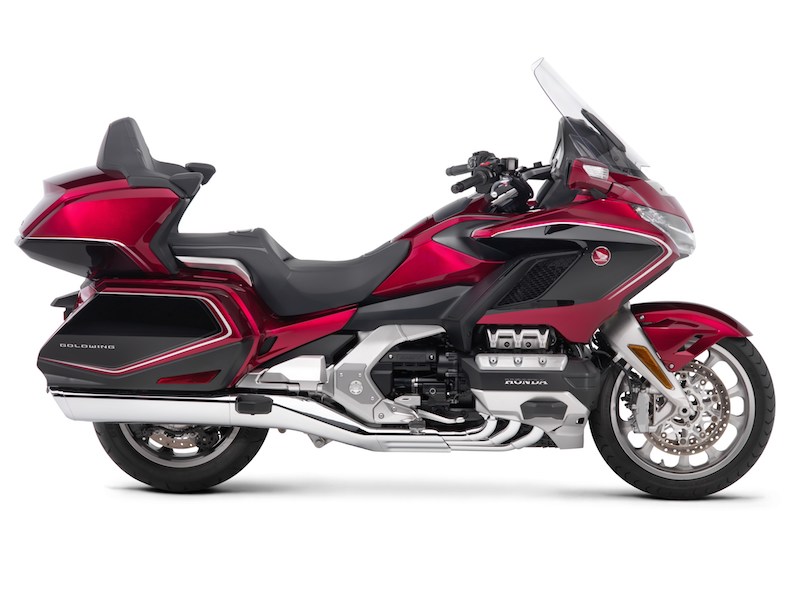

Dual Clutch Transmission (DCT)
Honda’s Dual Clutch Transmission is in its third generation and is the first to have seven speeds.
Honda claims it is smooth, fast shifting and lighter than the previous five-speed manual.
DCT delivers consistent, seamless gear changes up or down. It uses two clutches: one for start-up and 1st, 3rd , 5th and 7th gears: the other for 2nd, 4th and 6th. The mainshaft for each clutch is inside the other for compact packaging.
Each clutch is independently controlled by its own electro-hydraulic circuit. When a gear change occurs, the system pre-selects the target gear using the clutch not currently in use. The first clutch is then electronically disengaged as, simultaneously, the second clutch engages.
As the twin clutches transfer drive from one gear to the next with minimal interruption of the drive to the rear wheel, any gear change shock and pitching of the machine is minimised.
Honda claims it will be more durable as the gears cannot be damaged by missing a gear, is impossible to stall, provides low-stress urban riding and reduced rider fatigue.
In the lower speed range of the new Gold Wing’s DCT system, the ratios are close, reducing shift-shock and in the higher speed range set wider apart to reduce engine rpm.
Noise damper rubbers on both ends of the fork guide and the master arm reduce sound and shock during gear changes.
A spring damper has been installed between the clutch and the main shaft to absorb the torque in the rotational direction. This also reduces noise and shock of the contact between the clutch and main shaft when shifting gears.
The new Gold Wing’s DCT features a 1.8km/h forward Walking Mode with reverse of 1.2km/h, operated instantly from a +/- switch on the left handlebar.
Of the main shafts with a double tube structure, the outer main shaft connected with the even-number gears is linked to the inner shaft with a chain, via gears on the counter shaft. This gives the outer main shaft the role of the reverse idle shaft which results in a lightweight and compact reverse mechanism. There is no need for any reverse idle shaft.
When activating Walking Mode the two clutches of DCT enable moving backward with clutch #1 and moving forward with clutch #2. Moving forward or back at walking speed is now possible with only clutch control, without any need for gear shifting. The throttle-by-wire system also controls speed by minutely controlling the clutch capacity, while maintaining a certain engine speed.
The four riding modes are interleaved with DCT. All share the same engine character, delivery and suspension settings as the MT model but add extra DCT-specific parameters. TOUR uses the default setting for smooth clutch engagement and gearshifts in AT mode, with a low-to-high rpm range for gear shifts. SPORT deploys a more direct clutch engagement, with gear shifts programmed in a mid-to-high rev range.
ECON has a soft clutch engagement, with low-to-mid rpm gear hold and default shifting feel. RAIN also operates a soft clutch, low-to-high rpm gear hold range and slower shifting in AT mode.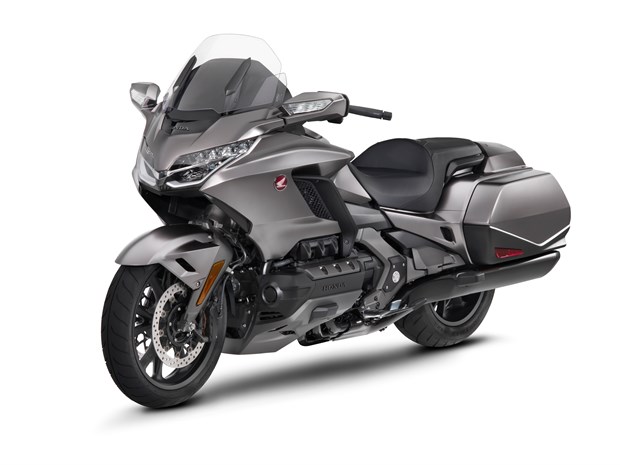

Technical specifications
| ENGINE | |
| Type | Liquid-cooled 4-stroke 24 valve SOHC flat-6 |
| Displacement | 1,833cc |
| Valves per cylinder | 4 |
| Bore x Stroke | 73mm x 73mm |
| Compression Ratio | 10.5:1 |
| Max. Power Output | 93kW/5500rpm |
| Max. Torque | 170Nm/4500rpm |
| Oil Capacity | 4.4 litres (MT) / 5.6 litres (DCT) |
| FUEL SYSTEM | |
| Carburation | PGM-FI electronic fuel injection |
| Throttle Bore | 50mm |
| Air cleaner | Viscous, cartridge type paper filter |
| Fuel Tank Capacity | 21.1 litres |
| Fuel Consumption | 5.6 litres/100km |
| ELECTRICAL SYSTEM | |
| Starter | Integrated Starter Generator system |
| Battery Capacity | 12V/20AH |
| ACG Power Generation Capacity | 12V/120A |
| DRIVETRAIN | |
| Clutch Type | (MT) Hydraulic, wet, multiplate with coil springs, assist slipper cam
(DCT) Hydraulic, wet, multiplate with oil pressure |
| Transmission Type | 6 speed MT (including overdrive. Plus electric reverse)
7-speed forward and reverse DCT |
| Primary Reduction | 1.795 (79/44) |
| Gear Ratios | (DCT) 1st: 2.167 2nd: 1.696 3rd: 1.304 4th: 1.038 5th: 0.821 6th: 0.667 7th: 0.522 Rev: 1.190
(MT) 1st: 2.200 2nd: 1.417 3rd: 1.036 4th: 0.821 5th: 0.667 6th: 0.522 |
| Final Reduction | Engine side 0.972
Rear Wheel side 2.615 |
| Final Drive | Enclosed shaft |
| FRAME | |
| Type | Aluminum die-cast, twin tube |
| CHASSIS | |
| Dimensions (L´W´H) | Gold Wing
L: 2,475mm W: 925mm H: 1,340mm
Gold Wing ‘Tour’ L: 2,575mm W: DCT 905mm / MT 925mm H: 1,430mm |
| Wheelbase | 1695mm |
| Caster Angle | 30.5° |
| Trail | 109mm |
| Turning radius | 3.4m |
| Seat Height | 745mm |
| Ground Clearance | 130mm |
| Kerb Weight | Gold Wing: 365kg
Gold Wing ‘Tour’: MT 379kg / DCT 383kg |
| SUSPENSION | |
| Type Front | Double Wishbone |
| Type Rear | Pro Link |
| WHEELS | |
| Type Front | 130/70R 18 |
| Type Rear | 200/55R 16 |
| Rim Size Front | 18 x MT3.5 |
| Rim Size Rear | 16 x MT6.0 |
| BRAKES | |
| System Type | Electronically-controlled combined ABS system |
| Type Front | 320mm x 4.5mm dual hydraulic disc with 6-piston calliper, floating rotors and sintered metal pads |
| Type Rear | 316mm x 11mm ventilated disc with 3-piston calliper and sintered metal pads |
All specifications are provisional and subject to change without notice.


